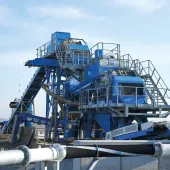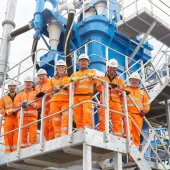Hydro-Clean uses up to 75% less water

Haver & Boecker offer a sustainable alternative to traditional log-washers and screws
THE Hydro-Clean washing unit from Haver & Boecker is said to effectively clean deleterious material from aggregate, recycled and other minerals while reducing water consumption by as much as 75%, compared with traditional log-washers.
Unlike traditional washing systems that can require as many as three screens along with a log-washer or screw, the producer only needs an additional wash screen for the Hydro-Clean’s discharged material. The washer comes in three model sizes – HC350, HC1000 and HC2000 – that process from 18 to 360 tons/h, depending on the application.
Taking feed material as large as 6in (150mm) into its vertical drum, the Hydro-Clean employs high-pressure nozzles, rotating at 90 rev/min, to spray as much as 90% recycled water on the material at pressures as high as 2,000 psi (140 bar). The washing unit removes silt and clay particles as small as 63 microns from mineral mixtures, and depending on the model and application, is capable of processing up to 360 tons/h with its short retention times.
Due to its compact size and weight, overall operating and structural costs are said to be considerably lower than with traditional washing systems, which also require more equipment and a larger footprint.
The Hydro-Clean consumes minimal water and power. Water consumption ranges from 27 to 211 gal/min, depending on application and model size. In comparison, log-washers use as much as 800 gal/min. Also, power requirements for the Hydro-Clean also are less than log-washers; Haver & Boecker’s largest model uses no more than 300 hp (225kW). When compared with conventional systems, the Hydro-Clean experiences little wear thanks to a maintenance-friendly design that allows for easy exchange of the few standard components.
Suitable for use in clay-heavy material deposits, dirty material is fed, via a hopper, into the Hydro-Clean’s vertical drum. Once inside, high-pressure nozzles mounted at the top rotate and spray the material with water. The turbulence in the drum creates additional scrubbing and abrasive forces that enhance the cleaning process as the material travels down the drum cylinder.
High-pressure streams of water are injected into areas of the rock (holes, voids, cracks etc) that are difficult to reach with traditional cleaning methods, such as log-washers or screws – creating a cleaner product capable of generating higher sales value. In addition, many producers use the unit to turn material that was once waste into sellable product.
During the cleaning process, the washed material works its way down the drum and exits on to a discharge conveyor that leads to a wash screen. The screen removes any remaining dirt or clay still on the stone as it fractionates the material.









